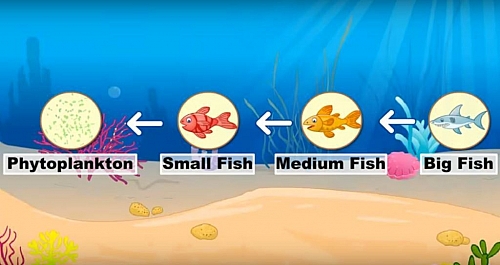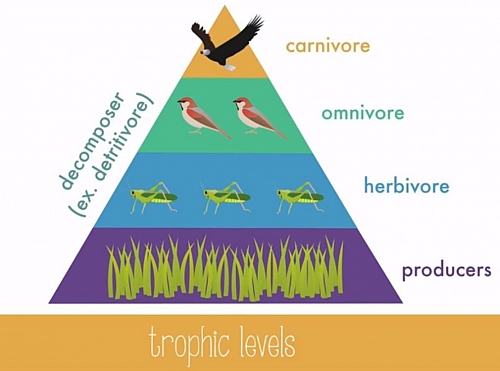The sun supplies all the energy needed by every living thing and this energy is used for growth, reproduction, digestion, movement and metabolism. Energy is trapped by plants to produce its own food (sugar) through a process called photosynthesis before it is transferred to animals who eat plants.
This is the beginning of the food web. In this case, the energy trapped by plant has been distributed to other organisms in a linear relationship (though not 100% of the energy, but about 10% of it). All organisms taking advantage of the energy that comes from plants are called consumers.
Plants who produce the food in the first place are known as producers. This is how ecologists explain a typical food chain in an ecosystem.
Table of Contents
What is food chain?
A food chain is defined as the feeding pattern of living organism in a given ecosystem, through which nutrients and energy are obtained, transfer and used up by one organism to another. A food chain shows a direct feeding pattern of living things, starting from the producer organism such as green plant or algae, which usually make its own from the sunlight.
It goes to primary consumer (herbivores) such as rabbits, who directly depends on the producer, it continuous with secondary consumer who also depends on the primary consumer and finally ends with the tertiary consumer who depends on the secondary consumer
The last stage is the decomposer which is not usually included in a typical food chain consists of bacteria and fungi which break down the foods into organic matter for plants to use it back as nutrients.
Trophic levels
In a food chain, living organisms are grouped into different categories called trophic level; these trophic levels however arrange these organisms according to their activities such as producer, primary consumer, secondary consumer and tertiary consumer.
A typical food chain starts with green plants ends with an animal at the top, in this food chain, the plant, which are the producer are been eaten by primary consumer or herbivore, and the primary consumers are then eaten by secondary consumer (carnivores), the secondary consumers are also eaten by tertiary consumers or the top carnivores). This is exactly how energy flows continuously in the chain.
The last level are the decomposers such as bacteria and fungi who feed on dead organic matter and then decompose and release all back to the plant in form of nutrients. In other word, living organisms when they die, they are often broken down into autotrophs, heterotrophs and saprotrophs. Autotrophs are the producers of the ecosystem.
Photosynthetic plants are autotrophs. Heterotrophs are the consumers that feed on the autotrophs or other heterotrophs. Heterotrophs are herbivores, carnivores or omnivores, while saprotrophs are the decomposers that break down dead plants and animals. Saprotrophs complete the energy cycle in an ecosystem by delivering nutrients to the soil.
However, there are some animals in an ecosystem that play two major roles within the same community, these animals are called omnivores; they eat both the producers and other consumers (both plants animals).
Examples of such animals are humans, bears, pigs and some parasites, which attach themselves to living tissue without harming them and at the same time are host to other smaller parasites. Different ecosystems have different food chains for instance, possible food chains that make up a food web. Marine food chain example – phytoplankton small fish seal Killer whale. Grassland food chain example- green plants rabbits fox lion
Since food chain explains only a linear relationship among plants and animals, there is another alternative that shows that each of these animals may not just feed on one type of food alone. They could be eating other animals too.
Other animals can also be eaten by more than one animal in the food chain to get their required energy. This complex system of interrelated food chains in an environment is called food web.
What is a food web?
A food web is a complex feeding relationships which show the different ways in which plant and animal obtain their food for survival, it is a combination of food chains that is linked to form a network.
Energy pyramid
In a food chain, plant are the first to receive energy from the sun, the amount of energy transferred to primary consumers is just about 10% which is small, and what is now transferred to secondary consumers may just be 1%, however, the secondary consumer would have to increase the number of primary consumers they eat to get more energy.
Since some food webs could have more than four feeding orders, at the third level we have the tertiary consumers, which are now left with the smallest percentage of energy, therefore, the tertiary consumers would have to eat more secondary consumers to add up to their energy.
This energy inefficiency limits the length of food chain in an ecosystem, because the length of food chain is often dependent on availability of energy, which means that the number of consumers at the top level will also reduce due to limited energy.
However, since the first level received more energy than the former, the energy pyramid therefore shows that the amount of energy transferred from one level to another decreases as you go higher in the food chain.



